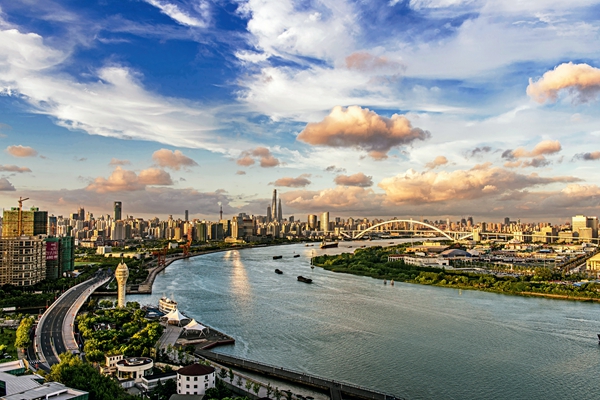West Bund: Cultural cluster on the Huangpu River
- By Yi Yun
 0 Comment(s)
0 Comment(s) Print
Print E-mail China Today, October 12, 2017
E-mail China Today, October 12, 2017
With a romantic and elegant ambience, the West Bund area in Shanghai, which once scintillated on the Maritime Silk Road, continues to thrive today.
Longteng Avenue, on the West Bund, stretches like a dragon along the Huangpu River, with Longhua Port and Rihui Port bridges at its head and tail. An area that once witnessed the rise of Chinese industry, the West Bund is now adapting to the modern era.
|
|
|
A panoramic view of the West Bund. |
By the end of 2017, an 8.4-kilometer-long scenic avenue, five bridges, and open recreational areas covering 80 hectares will have been constructed on the West Bund, enriching the amazing scenery along the banks of the Huangpu River. In the meantime, century-old industry bases will be conserved and repurposed in innovative forms.
Spots Around the Longhua Port Bridge
At a length of 3.7 kilometers, Long-hua is the most spacious port on the Huangpu River. This "dragon head" was once a triving port. Today, the glowing Longhua Port Bridge and the watchtower nearby highlight the view of the riverside at night.
A number of spots around the bridge are worth visiting. Yuz Museum, for example, is built in the hangar of the old Shanghai Aircraft Manufacturing Factory. Its rust-colored architecture looks striking against the background of river and trees. In addition, a runway park is constructed at the site of the former Longhua Airport, the biggest airport in the Far East in the 1930s and 1940s, offering urban dwellers an oasis in which to jog, stroll, and relax.
The watchtower right next to the bridge has changed its role of a beacon to a remarkable landmark by the riverside in Xuhui District. On top of that, Shanghai Dream Center – the leading element of the West Bund Media Port – is one of the largest cultural investment projects in China. The main construction is expected to finish by the end of 2017. Five large arenas, 10-plus small theaters, as well as diverse facilities will constitute a complex for entertainment, recreation, and retail.
New Look of Rihui Port Bridge
Rihui Port stands on a former watercourse flowing from the city to the Huangpu River. Senior locals can still recall the days when the port functioned as an open trench to discharge sewage. The narrow port, shallow water, low bridges, and bad environment used to be the main impression the district left on those who visited. However, over the course of the city’s rapid development, this image is replaced by a newly-built riverside resort area.
Several interesting places can be found adjacent to the Rihui Port Bridge. Nanpu Station, constructed in 1907, is the sole train station that contains a wharf in Shanghai. Old green carriages and an abandoned rail running alongside rows of bushes provide a wonderful setting for photos. Another representative is the Long Museum, which was the site of the Beipiao Wharf built in 1929 for coal transportation.
Enjoy the Open Air
Camp 3399 on No. 3399 Longteng Avenue is a grassland park. It is not only an open area where people can do sports such as basketball, rock climbing, skateboarding, and cycling, but also an ideal place to hold large-scale cultural events. Every year, a series of festivals for art, food, and music draw a great number of visitors.
Yi Yun is a freelance writer.







Go to Forum >>0 Comment(s)